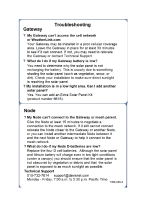
P/N 132031 rev. E 15
Banner Engineering Corp.•Minneapolis,MNU.S.A
www.bannerengineering.com•Tel:763.544.3164
SureCross™ FlexPower™ Data Radio
The DX80 Module complies with Part 15 of the FCC rules and
regulations.
FCC ID: UE300DX80-2400 This device complies with Part 15 of the
FCCRules.Operationissubjecttothefollowingtwoconditions:(1)
this device may not cause harmful interference, and (2) this device
must accept any interference received, including interference that
may cause undesired operation.
FCC Notices
IMPORTANT:TheDX80ModuleshavebeencertiedbytheFCCfor
use with other products without any further certification (as per FCC
section 2.1091). Changes or modifications not expressly approved
by the manufacturer could void the user’s authority to operate the
equipment.
IMPORTANT:TheDX80Moduleshavebeencertiedforxedbase
station and mobile applications. If modules will be used for portable
applications, the device must undergo SAR testing.
IMPORTANT:Ifintegratedintoanotherproduct,theFCCIDlabel
must be visible through a window on the final device or it must be
visible when an access panel, door, or cover is easily removed. If not,
a second label must be placed on the outside of the final device that
containsthefollowingtext:ContainsFCCID:UE300DX80-2400.
Note
This equipment has been tested and found to comply with the limits
for a Class B digital device, pursuant to Part 15 of the FCC Rules.
These limits are designed to provide reasonable protection against
harmful interference in a residential installation. This equipment
generates, uses, and can radiate radio frequency energy and, if not
installed and used in accordance with the instructions, may cause
harmful interference to radio communications. However, there is no
guarantee that interference will not occur in a particular installation. If
this equipment does cause harmful interference to radio or television
reception, which can be determined by turning the equipment off and
on, the user is encouraged to try to correct the interference by one or
moreofthefollowingmeasures:
Reorient or relocate the receiving antenna,•
Increase the separation between the equipment and receiving •
module,
Connect the equipment into an outlet on a circuit different from •
that to which the receiving module is connected, and/or
Consult the dealer or an experienced radio/TV technician for •
help.
AntennaWarningWARNING:Thisdevicehasbeentestedwith
Reverse Polarity SMA connectors with the antennas listed in Table
1 Appendix A. When integrated into OEM products, fixed antennas
require installation preventing end-users from replacing them with
non-approved antennas. Antennas not listed in the tables must
be tested to comply with FCC Section 15.203 (unique antenna
connectors)andSection15.247(emissions).
FCC-Approved Antennas
WARNING:Thisequipmentisapprovedonlyformobileandbase
station transmitting devices. Antenna(s) used for this transmitter must
be installed to provide a separation distance of at least 20 cm from all
persons and must not be collocated or operating in conjunction with
any other antenna or transmitter.
DX80 Module may be used only with Approved Antennas that have
been tested with this module.
Part Number Antenna Type Maximum
Gain
— Integral antenna Unity gain
BWA-2O2-C Omni, 1/2 wave dipole, Swivel ≤2 dBi
BWA-2O5-C Omni, Collinear, Swivel ≤5 dBi
BWA-2O7-C Omni, Coaxial Sleeve, Swivel ≤7dBi
Table 1. Type certified Antenna
FCC Certification, 2.4 GHz























